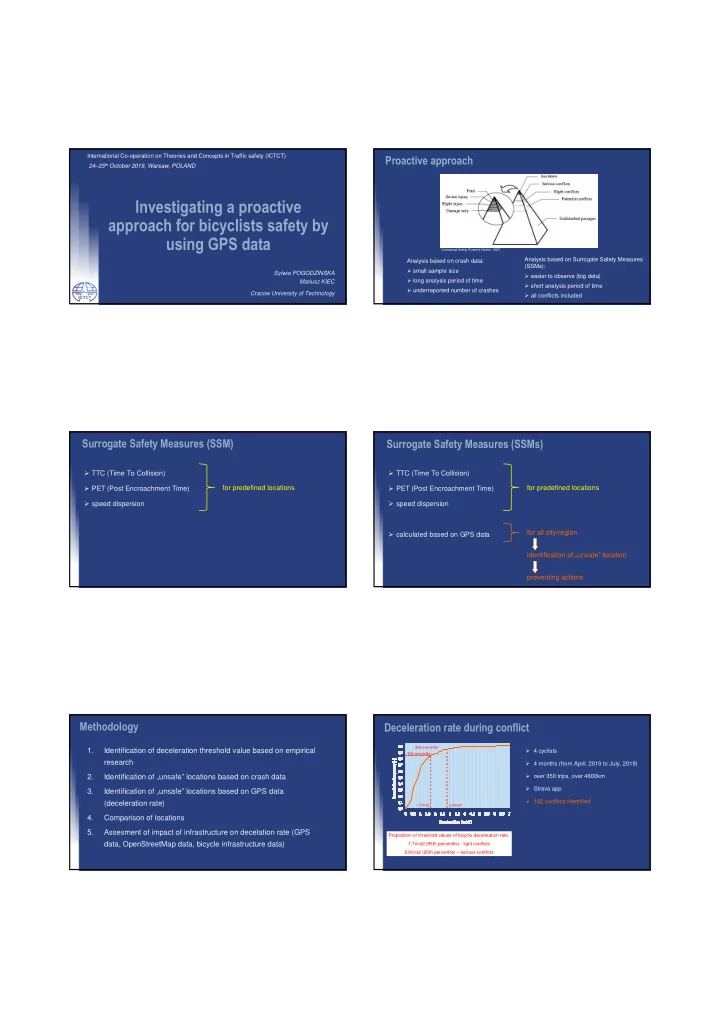

International Co-operation on Theories and Concepts in Traffic safety (ICTCT) Proactive approach 24–25 th October 2019, Warsaw, POLAND Investigating a proactive approach for bicyclists safety by using GPS data Conceptual Safety Pyramid (Hyden, 1987). Analysis based on Surrogate Safety Measures Analysis based on crash data: (SSMs): � small sample size Sylwia POGODZINSKA � easier to observe (big data) � long analysis period of time Mariusz KIEC � short analysis period of time � underreported number of crashes Cracow University of Technology � all conflicts included Surrogate Safety Measures (SSM) Surrogate Safety Measures (SSMs) � TTC (Time To Collision) � TTC (Time To Collision) � PET (Post Encroachment Time) for predefined locations � PET (Post Encroachment Time) for predefined locations � speed dispersion � speed dispersion for all city/region � calculated based on GPS data identification of „unsafe” location preventing actions Methodology Deceleration rate during conflict 95th percentile 1. Identification of deceleration threshold value based on empirical � 4 cyclists 85th percentile research � 4 months (from April, 2019 to July, 2019) � over 350 trips, over 4800km 2. Identification of „unsafe” locations based on crash data � Strava app 3. Identification of „unsafe” locations based on GPS data � 102 conflicts identified (deceleration rate) 1,7m/s2 2,8m/s2 4. Comparison of locations 5. Assesment of impact of infrastructure on decelation rate (GPS Proposition of threshold values of bicycle deceleration rate: data, OpenStreetMap data, bicycle infrastructure data) 1,7m/s2 (85th percentile) - light conflicts 2,8m/s2 (95th percentile) – serious conflicts
Crash data Deceleration rate during conflict 95th percentile � 4 years (2014-2017) � 4 cyclists 85th percentile � 938 injured crashes and 669 PDO (Property � 4 months (from April, 2019 to July, 2019) Damage Only) crashes with cyclists (1607 in total) � over 350 trips, over 4800km � Strava app „Unsafe” location - where 4 or � 102 conflicts identified more crashes occurred 1,7m/s2 2,8m/s2 (at least 1 per year on average) 25 „unsafe” locations identified Proposition of threshold values of bicycle deceleration rate: CROW threshold values of bicycle deceleration rate: 138 (8,6%) crashes with cyclists (92 1,7m/s2 (85th percentile) - light conflicts 1,5 m/s2 – comfortable braking (80th percentile) injured crashes, 46 PDO) 2,8m/s2 (95th percentile) – serious conflicts 2,6 m/s2 – emergency braking (94th percentile) Comparison Bikeshare system data (Wavelo) � 148 375 trips made in June, 2017 Why? � 108 conflicts in total � accuracy of GPS devices (e.g. signal disruptions) � impact of infrastructure (eg. visibility obstacles, Conflict - emergency braking with deceleration ≥ 2,6m/s2 traffic phases design) Wavelo bikes (source: www.lovekrakow.pl) � analysis based od GPS data can show „Unsafe” location - where 2 or Number of occurance more conflicts occurred locations where conflicts between cyclists and pedestrians occure (often not included in crash 12 „unsafe” locations identified data) 42 conflicts (39%) Acceleration [m/s2] Assesment of impact of infrastructure Results Bicycle infrastructure data Impact of Conflicts Bicycle infrastructure (1,5m/s2< dec.<7,0m/s2) GPS data OpenStreetMap data (eg. shops, bus stops, street lamps, parks, universities, hotels, restaurants)
Conclusions � using GPS data is a promising method in proactive approach for cyclists safety, � more indepth research should be done to investigate which SSMs and Thank you for your attention what threshold values should be adopted in analysis for different data sources, � SSMs and crash data should be both taken into consideration in decision making process, � necessity of combining deceleration data with other affecting cyclists Contact: Sylwia POGODZINSKA safety Cracow University of Technology Faculty of Civil Engineering spogodzinska@pk.edu.pl
Recommend
More recommend